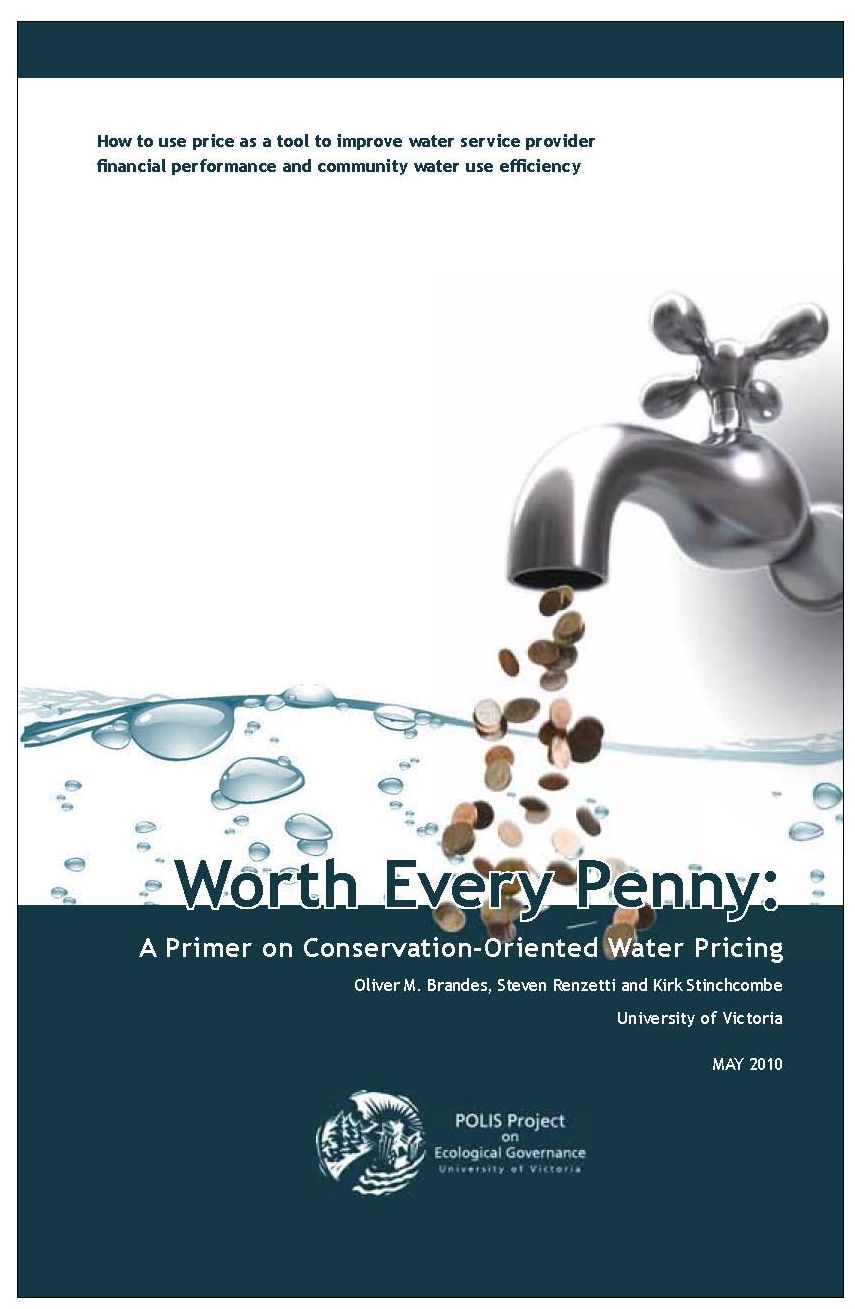WORTH EVERY PENNY: An Introduction to the Water Pricing Primer

FIFTH ANNOUNCEMENT: Pricing water service at closer to its true cost would help pay for infrastructure and reduce waste
“Think back to 10 years ago, when seven residents of the small, rural community of Walkerton, Ont., died, and more than 2,300 inhabitants fell ill, after a devastating outbreak of water-borne disease,” states Oliver Brandes, POLIS Associate Director and Water Sustainability Project Leader at the University of Victoria.
“Many factors contributed to this tragedy, but a pervasive lackadaisical attitude about the value of water is prominent among them. Although many lessons have been learned since then, Canadians still largely take their water for granted. We haven’t reconciled the need to properly value it to ensure lasting water security and sustainability.”
“Canadians pay far less for water than people in most other developed countries. It’s no coincidence that our per person water use is also among the highest in the world, rivalled only by the United States. With little financial incentive to conserve, we over-consume, and our over-consumption threatens water security, ecosystems and the sustainability of our water infrastructure.”
Stimulating a National Dialogue
“Inevitably, society has to pay for the infrastructure and services that store, treat and distribute water to our homes and businesses. Yet, Canadians typically pay only a portion of these costs through regular water bills,” continues Oliver Brandes.
“The remaining costs must be postponed, leading to deteriorating infrastructure. Alternatively, they must be subsidized from other sources, including infrastructure grants from provincial and federal governments or municipal government general revenue (usually generated from property taxes). This keeps the retail price of water artificially low.”
“POLIS is seeking to stimulate a national dialogue on conservation-oriented water pricing as part of a sustainable approach to management.”
Nanaimo Water Pricing Workshop
On September 9th, the Regional District of Nanaimo (RDN) is hosting a workshop titled Worth Every Penny: An Introduction to Conservation-Oriented Water Pricing and Sustainable Service Delivery.
To download a poster that is complete with pre-registration information, click on How you can register to participate in “Worth Every Penny: A Learning Lunch Workshop”
Worth Every Penny
Oliver Brandes and Kirk Stinchcombe will anchor the morning part of the program. They are two of the co-authors of Worth Every Penny: A Primer on Conservation-Oriented Water Pricing, released in May 2010.
 “Oliver and Kirk will tag-team in leading a session titled An introduction to the Water Pricing Primer. This segment is the cornerstone for the workshop. The knowledge-transfer provided by Oliver and Kirk will prime participants for the sharing of water pricing experience that will follow in the afternoon part of the program,” states Kim Stephens, Program Coordinator for the Water Sustainability Action Plan for British Columbia. He will be the workshop moderator.
“Oliver and Kirk will tag-team in leading a session titled An introduction to the Water Pricing Primer. This segment is the cornerstone for the workshop. The knowledge-transfer provided by Oliver and Kirk will prime participants for the sharing of water pricing experience that will follow in the afternoon part of the program,” states Kim Stephens, Program Coordinator for the Water Sustainability Action Plan for British Columbia. He will be the workshop moderator.
“Kirk will lead and I will provide colour commentary throughout the session,” explains Oliver Brandes. “Because the purpose is knowledge-transfer, we believe it would serve the audience to have more than one talking head.”
An Introduction to the Water Pricing Primer
“Effective conservation-oriented water pricing can help reconcile growing communities with the health of local watersheds and engage individuals and businesses to change their behaviour and begin reducing their water footprints,” continues Oliver Brandes. He explains that Kirk and his lesson plan has five objectives:
- Introduce participants to a national dialogue on the concept and application of conservation-oriented water pricing;
- Provide an overview of the current situation in Canada on key related issues such as metering, volumetric charging and municipal water rates;
- Explore how implementation challenges – such as avoiding impacts on low income families and maintaining water service provider revenue requirements – can be addressed;
- Provide advice on how to manage the inevitable political and communication challenges that arise when a community changes its approach to water pricing; and
- Provide participants with a “road map” on how to successfully implement pricing improvements in their areas.
“The Primer introduces water pricing reform options for water managers, policy-makers and municipal leaders across Canada. The report makes the economic case for water conservation and sustainable water service infrastructure as a way to increase water security for communities,” states Oliver Brandes.
The Infrastructure Deficit
“Water infrastructure in many Canadian towns and cities is deteriorating, and water bills are often not high enough to even cover the costs of continuing operations,” continues Kirk Stinchcombe.
 “In fact, Statistics Canada figures show that the aggregate ratio of what municipal water service providers brought in (revenue) compared with what they spent (expenditure) in 2007 was only 70% and is falling. In other words, water users are not even coming close to covering the full costs of the water services they enjoy — and it’s getting worse.”
“In fact, Statistics Canada figures show that the aggregate ratio of what municipal water service providers brought in (revenue) compared with what they spent (expenditure) in 2007 was only 70% and is falling. In other words, water users are not even coming close to covering the full costs of the water services they enjoy — and it’s getting worse.”
“To cover the gap, occasionally a federal or provincial government, looking to score political points, doles out money under variously branded ‘green’ (or in this case ‘blue’) infrastructure programs. But this is a Band-Aid solution for a geyser of a problem.”
A Better Solution
“A better solution is to begin charging individuals and businesses what water really is worth, based on the volume they use. However, you can’t manage what you don’t measure.”
“According to the most recent Environment Canada data (2006), over one-third of Canadian homes still do not have a water meter and the implementation of metering varies considerably from province to province. Surprisingly, only 32.6% of houses are metered in B.C., 16.5% in Quebec, and less than one per cent in Newfoundland, something that would be unthinkable in other basic utility services such as energy, natural gas or telephone.”
Charging What Water is Worth
“A few crucially important things will happen if we start charging what water is worth,” states Oliver Brandes.
“People will reduce their use simply because they know they will save money. Secondly, we’ll find newer and better designs for appliances and fixtures such as toilets and washing machines, and efficiencies for businesses.”
“Finally, municipalities and communities can start building financial programs that fully cover the costs of operating — including replacing water infrastructure — without relying on often piecemeal and generally unreliable infusions of money from Ottawa or their provincial capital,” concludes Oliver Brandes.
Moving to a 21st Century Approach
“Moving to effective water pricing will take time and probably a bit of courage on the part of municipal leaders,” observes Kirk Stinchcombe. “But we need to remember that it makes sound sense from both business and environmental points of view, and it can be done without hurting low-income families.”
“Wasting water and not being able to fund the operation of water systems are in nobody’s interest. It’s time Canadian communities moved to a 21st-century approach to water infrastructure planning and pricing.”


